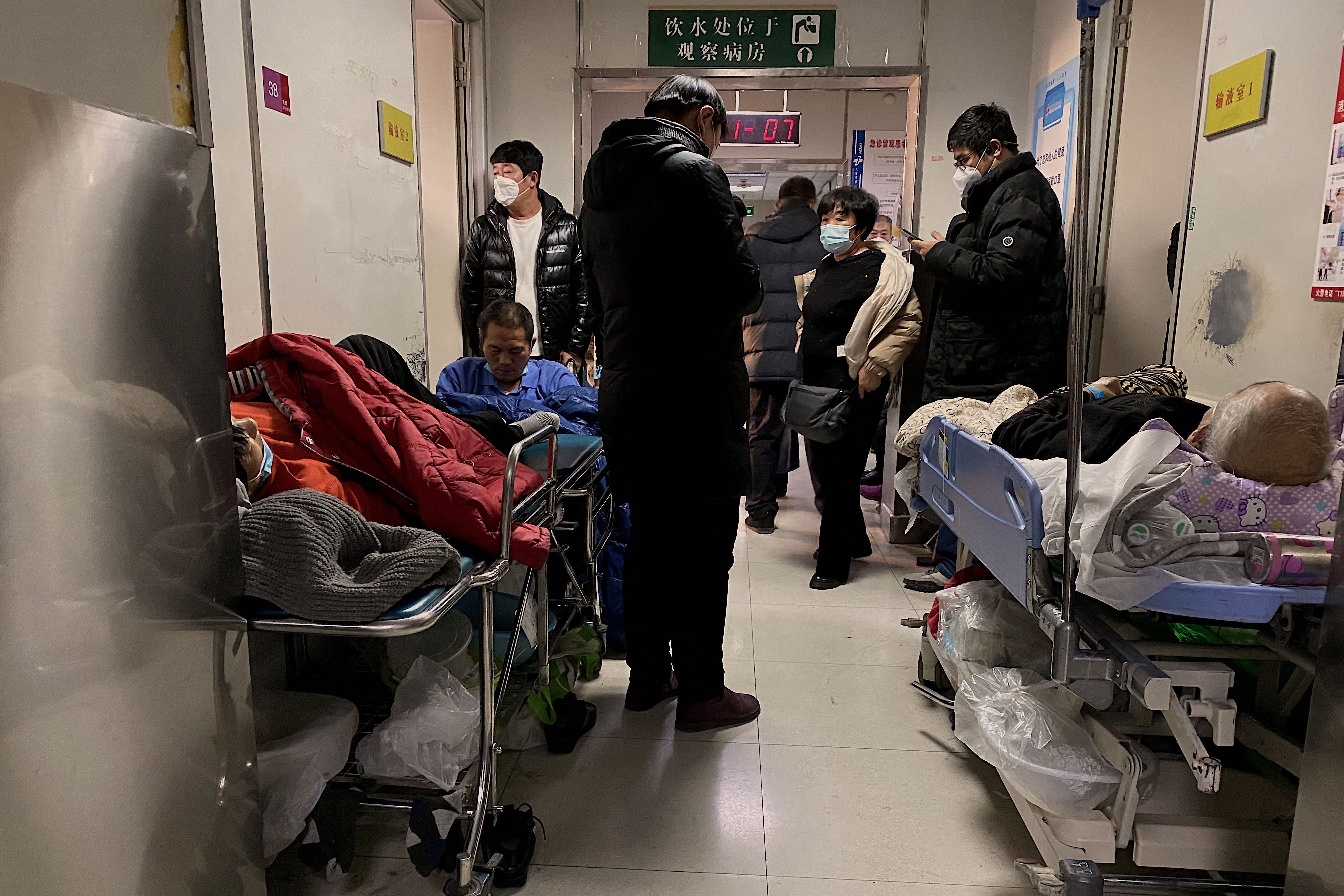
The World Health Organisation (WHO) is ramping up pressure on China to share key data on its latest coronavirus outbreak, using public statements and behind-the-scenes meetings to push Beijing as it tries to map the largest surge of the pandemic – even if it risks the government’s wrath.
It is a stark contrast to the WHO’s approach in early 2020, when its leader, Tedros Adhanom Ghebreyesus, praised China’s “transparency” on the new virus even as reports suggested Beijing had deliberately undercounted cases and silenced whistleblowers.
But the new approach might be paying off. China’s National Health Commission recently announced a significant revision of its data, raising the death toll in hospitals since severe coronavirus restrictions were lifted in December from 37 to nearly 60,000. At the same time, Ma Xiaowei, director of China’s National Health Commission, shared much of the same data with Tedros, according to a WHO readout of a call between them.
WHO officials are unsure why China released the data now – and in interviews were hesitant to take responsibility. The numbers appear to show an outbreak similar to the waves of omicron that washed over other countries a year ago. It also suggests the new wave of infections had peaked, possibly reassuring news before the lunar new year, a period of intense holiday travel.
But there are also significant gaps, including in detailed regional data and information over time. It also lacks the detailed genome sequencing that WHO and others have requested to track any new variants. “It’s really sad to see the number of hospital-related deaths of 60,000 in the last month, but that should be considered the minimum,” says Maria Van Kerkhove, the WHO’s technical lead on Covid-19. The data, she notes, does not appear to include deaths outside of hospitals.
Still, it is more information than China has typically provided. Before last Saturday, Beijing had released little data on the outbreak, which grew exponentially after the government lifted its “zero Covid” policy on 7 December, ending mass testing, harsh lockdowns and lengthy quarantines. The secrecy around the latest outbreak had heightened concern among global health officials and analysts that new variants could be spreading undetected.
Van Kerkhove says the release confirmed to the WHO one important thing: “It tells us that this data exists.”
China’s National Health Commission stopped reporting daily case counts in December. From 1 November to 13 January, the Chinese Centre for Disease Control and Prevention reported fewer than 50 deaths, a figure analysts say is implausibly low.

J Stephen Morrison, director of the Global Health Policy Center at the Center for Strategic and International Studies, calls that data “ludicrous” and says it has undermined China’s reputation. “No one believes it,” he says. “What’s the point?”
For much of the past three years, Chinese authorities blocked international travel and imposed strict quarantines to stamp out the virus – and avoided the worst of the pandemic. But as this winter approached, more contagious offshoots of the omicron variant began to spread, despite the harsh restrictions, and rare protests against the restrictions prompted officials to reverse course, lifting almost all of them.
Soon, authorities in many major cities, including Beijing, were reporting fast-spreading outbreaks. Satellite imagery of crematoriums suggested China has suffered many more deaths than the government has acknowledged.
As reports drew an increasingly dire picture, the WHO increased pressure, publicly and privately. Tedros repeatedly called on the Chinese government to report the number of hospital admissions and other information. The WHO urged China to share data on disease severity, the number of patients in intensive care and genomic sequencing.
The WHO also held several private meetings with Chinese officials, in addition to their regular contact in Beijing, where the organisation maintains an office. The meetings have been professional, according to those involved, but the message is clear: where is the data?
Van Kerhove says WHO and other officials know the quality of China’s health data, having seen it on visits in early 2020. “The scientific capacity in China is pretty incredible,” she says. The WHO has no authority to compel China to release data – but it can keep asking.

One shortcoming in the data is the way that China counts its deaths, which WHO officials consider unusually restrictive. According to WHO emergencies head Mike Ryan, China registers deaths as coronavirus-related only if the cause is respiratory failure and a positive coronavirus test has been recorded.
The new data is more expansive – it shows 5,503 died from respiratory failure caused by the virus and 54,435 died with underlying diseases combined with Covid-19 (54,435). Still, some analysts remain sceptical.
“The new official numbers are most likely not a reflection of the total number of Covid-related deaths,” says Louise Blair, head of vaccines and epidemiology at Airfinity. The science-forecasting group has said China’s omicron wave likely caused more than 413,000 deaths. “These numbers imply a much lower number of deaths per capita in China than all other major countries have experienced.”
Liu Pengyu, spokesperson for the Chinese Embassy in Washington, said last week that China has followed the same standard for counting deaths since 2020. Liu said China had “been sharing information and data with the international community in an open and transparent manner” since Covid-19 was first identified. including sequencing data for the virus.
“In the past month alone, we had five technical exchanges with [the WHO]”, he added.
WHO officials confirm an uptick in meetings with China. Officials from China’s CDC this month attended a virtual meeting of the WHO’s Technical Advisory Group for Virus Evolution, or TAGVE, to present genomic data. Chinese officials also gave an update on the situation at a meeting of member states. According to TAGVE, the China CDC data shows a predominance of omicron lineages BA.5.2 and BF.7 circulating. Both are already common around the world.
Elodie Ghedin, a Canadian virologist who was present at the meeting, says the discussion included an overview of how genomic surveillance is working in China. CDC officials there choose one hospital in a key city in each province to monitor, then extrapolate a broader view.
“They run it through the same analysis pipeline that everybody else in the world does,” Ghedin says. Sequencing has declined worldwide, so China’s approach isn’t unusual, but the scale of the surge there makes it worrying, she adds. “In China, I would have hoped there would have been a bit more surveillance. It seems a little low, in my opinion.”
Meeting participants raised concerns that China was not sharing more of its genomic sequencing from the outbreak with GISAID, a global platform for coronavirus data. According to Ghedin, Chinese officials responded that they hoped to study the data first and then publish their own research.
“We’ve heard this argument for decades,” she says. “People are always going to get scooped.”
So far, the Chinese response to the WHO’s pressure has been relatively muted compared to previous episodes.
Chinese officials reacted with fury in 2021 when Tedros criticised the results of a joint WHO-China probe into the origins of Covid-19, which dismissed the idea that the virus could be linked to a lab in Wuhan. Beijing censored Tedros on online platforms last year after he said its “zero Covid” policy was unsustainable.
But at a news briefing earlier this month, Chinese Foreign Ministry spokesperson Wang Wenbin called on the WHO to “look at China’s Covid response scientifically and rationally, and that its related statements will reflect objectivity and impartiality.”
In the meantime, Van Kerkhove says, work at the WHO’s office in Beijing’s diplomatic district continues. But staff there are dealing with another problem: their own outbreak. “Many of them have been sick,” Van Kerkhove says. “You know, like most people across the country.”
© The Washington Post







